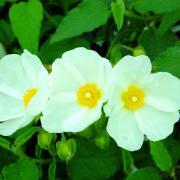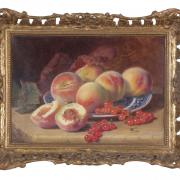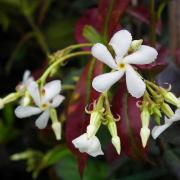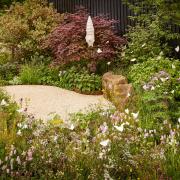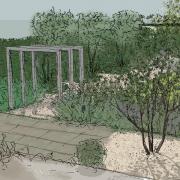Plant specialist Keith Clouting of Taverham Nursery shares his seasonal gardening advice
PUTTING ON A SHOW
May is perhaps the busiest and most rewarding time to be out in the garden. With the days getting longer and warmer plants which have been stored for the winter can be placed outside in their summer positions, and bedding, tender vegetables and herbs can be planted out to create your own oasis of colour and greenery.
One of the many groups of plants putting on their best show in May are Choisya. These easy to grow shrubs are an asset to any garden and in recent years many new cultivars and varieties have been introduced to extend the range so there’s one for most situations sun or part shade.
One of the finest new varieties is Choisya x dewitteana ‘Apple Blossom’ which has elegant finely cut scented evergreen leaves which are complemented in late spring by masses of scented flowers which are pink in bud opening light pink then fading to white giving the plant a bicolour appearance. A second flowering usually occurs in late summer. ‘Apple blossom’ is a compact shrub eventually reaching around 1.5m. Like other Choisya it can be trimmed to maintain size or shape just after flowering.
Another relatively new variety is Choisya x dewitteana ‘Little Bee’ which has glossy, narrow dark green leaves on a dwarf plant reaching only around 60cm which makes it an excellent choice for a container or front of a sunny border. Like Apple Blossom it flowers twice a year, pink in bud the flowers open white and star like and of course are loved by bees.
Among good golden leaved varieties is C.x d. ‘Aztec Gold’ a beautiful variety with slender golden yellow aromatic foliage, its brightest colour is in full sun but still colourful in part shade.it has the same wildlife friendly white flowers and like the other C.x dewitteana prefers well-drained soil sheltered from cold damaging winds in winter.

PLANT OF THE MONTH
Wisteria frutescens ‘Amethyst Falls’
If you are looking for a stunning climber to adorn your garden, you can't go wrong with Wisteria frutescens ‘Amethyst Falls’. This wisteria native to North America, flowers from an early age and is more compact than most varieties producing cascading clusters of fragrant, lavender-blue flowers in late spring and early summer. It can be trained on a trellis, arbour, fence or walls and unlike most wisterias it can also be grown well in a container.
Amethyst Falls flowers best in full sun in fertile moist but well-drained soil. If growing in a container a soil-based compost should produce the best results.

QUESTION FOR KEITH
I have several Hylotelphium spectabile (formally sedum) which I love but when flowering later in the year they always seem to splay open, is there any way of preventing this?
These fabulous plants beloved by butterflies and bees can get top heavy when flowering. The best way to help prevent this is by cutting them back by up to half in mid to late May. This creates a shorter, bushier plant which should stay more upright. This is sometimes referred to as the Chelsea chop as it’s around the time of the Chelsea Flower Show. If some splaying still occurs placing a few supporting medium sized stones under the plant to support the stems also helps. Other plants which can benefit from chopping back include Achillea, Phlox paniculata and tall growing Campanulas.
Catch up with Keith
Half-hardy plants started off inside should be gradually hardened off ready for planting out towards the end of the month when the danger of frost has passed.
Clematis montana which are untidy or outgrowing their space can be pruned back as soon as the flowers have finished.
If frosts are forecast earth up potatoes to protect emerging shoots from frost damage.
Keep newly planted lawns from seed or turf well-watered to help them establish well.
If space is limited try growing short catch crops such as radish, spring onions or lettuce etc. in-between longer-term crops such as brassicas.




